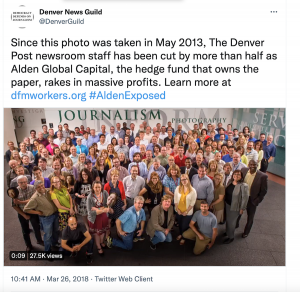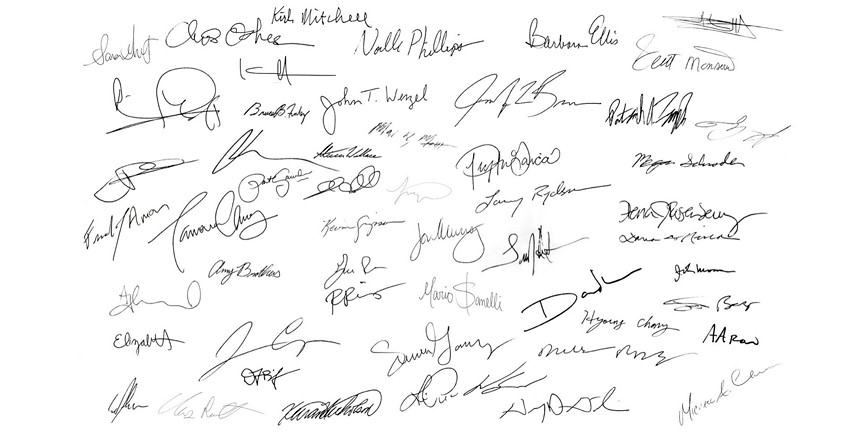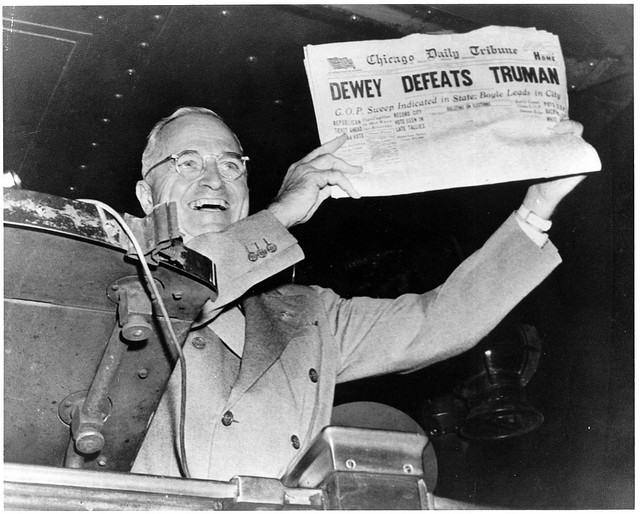23 4.5 Current Popular Trends in the Newspaper Industry
Learning Objectives
- Identify newspapers with high circulations.
- Describe the decline of the newspaper industry.
Popular media such as television and the Internet have forever changed the newspaper industry. To fully understand the impact that current technology is having on the newspaper industry, it is necessary to first examine the current state of the industry.
The Hedge-Fund Takeover of the Denver Post
In the last 25 years, the newspaper industry has been rapidly changing with the rise of the internet, the decrease of advertising revenue as companies shift their focus to online companies like Google and Facebook, layoffs of journalists, and corporations and hedge-fund companies buying up local newspapers. Nowhere is this more evident than in Colorado. For over 100 years, Colorado had multiple newspapers to serve its readers, lead by The Rocky Mountain News, which shut down in 2009, and the Denver Post, which was bought out by venture capitalists Alden Global Capital in 2010. While amazing online news outlets have come into existence in the last few years, like Denverite and The Colorado Sun, as well as the expansion of Colorado Public Radio. Westword, an independent and free newspaper that’s been going strong since 1977, wrote about the Denver Post’s change in ownership and the repercussions back in 2018, eight years after Alden brought it, and the newsroom tried to fight back. This fight is also the subject of the documentary News Matters, which is on Kanopy (a free streaming service available through public and academic libraries like Arapahoe Community College’s).
Denver Post Journalists’ Vulture Hedge Fund Fight: Two Cities, Two Protests

Today in two cities, Denver and New York, Denver Post employees will be taking part in separate demonstrations against Alden Global Capital, the vulture hedge fund that has so gutted the newspaper that former owner Dean Singleton chose to resign as chairman and step down from the editorial board as a way of expressing his frustration and disappointment.
Noelle Phillips, a Post reporter and vice-chair of the Denver Newspaper Guild unit for the publication, understands Singleton’s point of view. But she stresses that the sixty-plus newsroomers still employed by the Post (down from 310 a little over a decade ago) are ready, willing and able to fight for what they believe.
“I would say there’s a lot of anxiety,” she acknowledges. “But there are also a lot of fiery, passionate journalists who still want to do good journalism.”
As proof, note that Phillips and three other Post staffers are participating in a noon Eastern/10 a.m. Mountain time protest at the so-called Lipstick Building, at 885 Third Avenue in NYC, where Alden Global Capital’s offices are located. And at noon Mountain, another rally will take place at the 5990 Washington Street Post printing plant in Adams County where the paper’s newsroom recently relocated. There, Post employees and representatives from the guild, supplemented by members of the community, will deliver a message that Phillips summarizes like so: “Invest in your newspapers or sell them.”
This opinion is widely held. The Denver Newspaper Guild has released a letter protesting the treatment of Post editorial-page editor Chuck Plunkett, who stepped down after an executive with Digital First Media, which Alden controls, spiked a piece critical of the hedge fund. (Rolling Stone has now published Plunkett’s description of the events.) The letter is on view below, along with a list of more than fifty signatories from the paper — though at least two, senior editors Dana Coffield and Larry Ryckman, recently left.
Theirs aren’t the only departures. Also cutting ties with the paper is Steve Lipsher, a former Post staff member who’s been writing a monthly op-ed column. In a goodbye note on Facebook, Lipsher wrote, “I wish nothing but the best for the survivors at the Post, and a pox upon the house of Alden Capital.”
The following video, issued by the guild to illustrate the Post newsroom’s shrinkage in recent years, helps explain why Lipsher and others feel so strongly.
(The photos below was published by the Denver Post opinion page in 2018 to show Alden’s impact on the newsroom.)


In his recent Westword interview, Singleton talked about how diminishing resources at the Post meant there simply weren’t enough bodies to send to all of the hearings and events that deserved coverage. One example: Denver Police Chief Robert White announced his plans to retire at a recent citizen-oversight board meeting, but the story didn’t break until several days later, because no reporter was on hand.
Phillips, who specializes in law-enforcement coverage (she got the scoop on White’s decision), stresses, “I still occasionally go to those meetings, but I just can’t make them all — and I’ll sometimes go to meetings where I’m the only media there. It just gets harder and harder to do when you have a smaller and smaller staff.”
The personnel reductions mean those who remain face more chores than they can possibly complete. In Phillips’s words, “Everybody works really hard. There are no slackers at the Denver Post. The slackers are long gone.” She notes that on May 4, amid the rash of resignations, “there were still reporters there at 7 o’clock at night, finishing their stories, getting them done for the weekend — still doing their job.”
In New York, Phillips and the Post contingent will be joined by representatives from the Communications Workers of America and a number of Digital First Media papers, including Minnesota’s St. Paul Pioneer Press, Kingston, New York’s The Daily Freeman and California’s San Jose Mercury News. About 150 protesters are expected, and they’ll deliver a petition with approximately 11,000 signatures from folks who want Alden to either provide its newspapers with enough resources to adequately cover the news or find buyers willing to do so.
If new owners materialize, Phillips says, they’ll find plenty of journalists ready and raring to go. “Our DNA is to do a good job no matter the circumstances,” she says. “We have an internal drive — and that’s what I intend to do. I tell people, ‘I want to continue to be a journalist and I want to stay in Denver.'”

Denver Post Newsroom Statement on Resignation of Editorial Page Editor Chuck Plunkett
To our readers:
Newspapers tell the truth.
They must. Always.
That is why we, the newsroom of The Denver Post, are outraged at the unconscionable censorship imposed on our now-former editorial page editor, Chuck Plunkett. Chuck told the truth, eloquently and pointedly. And in that our newspaper’s corporate ownership — Digital First Media and the hedge fund Alden Global Capital — saw something to fear, not to champion.
Chuck resigned Thursday after the chief operating officer of DFM, Guy Gilmore, blocked Chuck from publishing an editorial that forcefully criticized DFM and Alden. Chuck’s resignation followed the firing last month of the editorial page editor for our corporate sibling, the Boulder Daily Camera, who also spoke out against our owners. This censorship harms our readers, and we are concerned it also threatens the newsroom’s independence. It requires journalists to work in an unacceptable climate of intimidation, worried that telling the truth will lead to dismissal.
For years, the companies have blamed journalists and the reading public for the steady decline in their newspapers’ quality. In Chuck’s banned editorial, you can read the facts: According to an independent report, Alden and DFM reaped $160 million in profits from their newspapers across the country in 2017, including $28 million from The Denver Post.
In that time, the corporate owners — led by Alden bosses Heath Freeman and Randall Smith — slashed budgets and laid off reporters, editors, photographers, designers, producers, pressmen, advertising reps, customer service personnel and other members of the newspaper family. Journalism in those places withered, the powerful impact on community and accountability that newspapers provide did too, and only a handful of wealthy individuals benefited.
Those are not the actions of owners who appear to care about journalism or about Colorado.
Though Chuck’s province at the newspaper was opinion and we, the newsroom, operate with strict ethical rules for objectivity, we have always shared a common purpose. We tell the truth, even when it is difficult. We tell the truth, even when the subject hits close to home.
There was an inscription that decorated the front of one of The Denver Post’s earliest buildings that read: “O Justice, when expelled from other habitations, make this thy dwelling place.”
For 125 years, that has been a solemn vow that The Denver Post has made to its readers, and it is one Chuck and we in the newsroom intend to keep.
It has become vividly clear that Alden and DFM do not share in that vow. It has become vividly clear that they are undeserving of owning The Denver Post and of serving you. It has become vividly clear that they must either invest in the newspaper or sell it to someone who cares about Colorado, and they must do it immediately.
That is the truth.
Signed:
John Aguilar, Suburbs Reporter
Joe Amon, Photographer
Torin Berge, Deputy Sports Editor
Dan Boniface, Digital Director, Sports
Amy Brothers, Digital Photo/Video Editor
Jennifer Brown, Investigations Reporter
Mike Chambers, Avalanche Reporter
Hyoung Chang, Photographer
Tamara Chuang, Technology Reporter
Dana Coffield, Senior Editor
Adrian Crawford, Digital Producer
Andy Cross, Photographer
Barb Ellis, Features Editor
Bruce Finley, Environment Reporter
Peyton Garcia, Community Journalist
Susan Gonzalez, Digital Producer
Sara Grant, Editor, The Know
Greg Griffin, Business/Investigations Editor
Kevin Hamm, Digital Producer
Elizabeth Hernandez, Breaking News Reporter
TJ Hutchinson, Systems Editor
John Ingold, Health/Enterprise Reporter
Mike Judson, Assistant Editor
Eric J. Lubbers, Director of Innovation
Mark Matthews, Politics Reporter
David Migoya, Investigations Reporter
Kirk Mitchell, Breaking News Reporter
Scott Monserud, Assistant Managing Editor, Sports
John Mossman, Copy Editor
Jon Murray, City Hall Reporter
Joe Nguyen, Digital Producer
Kieran Nicholson, Breaking News Reporter
AAron Ontiveroz, Visual Journalist
Chris Osher, Investigations Reporter
Jesse Paul, Politics Reporter
Noelle Phillips, Police Reporter
Lori Punko, Content Coordinator
Helen Richardson, Photographer
Chris Rickett, Politics Editor
Becky Risch, Digital Director
Dena Rosenberry, Deputy City Editor
Joe Rubino, Business Reporter
Larry Ryckman, Senior Editor
Mario Sanelli, Editorial Assistant
RJ Sangosti, Photographer
Patrick Saunders, Rockies Reporter
Daniel J. Schneider, Digital Producer
Megan Schrader, Editorial Writer
Kevin Simpson, General Assignment/Enterprise Reporter
Aldo Svaldi, Real Estate/Economy Reporter
Patrick Traylor, Photo Editor
Alicia Wallace, Business Reporter
John Wenzel, Reporter
Monte Whaley, Education Reporter
Danika Worthington, Breaking News Reporter
Major Publications in the U.S. Newspaper Industry
Although numerous papers exist in the United States, a few major publications dominate circulation and, thus, exert great influence on the newspaper industry. Each of these newspapers has its own unique journalistic and editorial style, relying on different topics and techniques to appeal to its readership.
USA Today
USA Today currently tops the popularity chart with a daily circulation of 2,281,831 (Newspapers). This national paper’s easy-to-read content and visually focused layout contribute to its high readership numbers. Although the paper does not formally publish on weekends, it does have a partner paper titled USA Weekend. USA Today consists of four sections: news, money, sports, and life; for the ease of its readers, the newspaper color-codes each section. Owned by the Gannett Company, the paper caters to its audience by opting for ease of comprehension over complexity.
The Wall Street Journal
Established in the late 1800s, The Wall Street Journal closely trails USA Today, with a circulation of 2,070,498 (Newspapers). In fact, USA Today and The Wall Street Journal have competed for the top circulation spot for many years. An international paper that focuses on business and financial news, The Wall Street Journal primarily uses written narration with few images. Recent changes to its layout, such as adding advertising on the front page and minimizing the size of the paper slightly to save on printing costs, have not dramatically shifted this long-standing focus. The paper runs between 50 and 96 pages per issue and gives its readers up-to-date information on the economy, business, and national and international financial news.
The New York Times
The New York Times is another major publication, with circulation at 1,121,623 (Newspapers). Founded in 1851, the New York City–based paper is owned by the New York Times Company, which also publishes several smaller regional papers. The flagship paper contains three sections: news, opinion, and features. Although its articles tend to be narrative-driven, the paper does include images for many of its articles, creating a balance between the wordier layout of The Wall Street Journal and the highly visual USA Today. The New York Times publishes international stories along with more local stories in sections such as Arts, Theater, and Metro. The paper has also successfully established itself on the Internet, becoming one of the most popular online papers today.
Los Angeles Times
The Los Angeles Times—currently the only West Coast paper to crack the top 10 circulation list—has also contributed much to the newspaper industry. First published in 1881, the California-based paper has a distribution of 907,977 (Newspapers). Perhaps the most unique feature of the paper is its Column One, which focuses on sometimes-bizarre stories meant to engage readers. Known for its investigative journalistic approach, the Los Angeles Times demands that its journalists “provide a rich, nuanced account” of the issues they cover (Los Angeles Times, 2007). By 2010, the paper had won 39 Pulitzer Prizes, including five gold medals for public service (Los Angeles Times).
The Washington Post
First published in 1877, The Washington Post is Washington, DC’s oldest and largest paper, with a daily circulation of 709,997 (Top 10 US Newspapers by Circulation). According to its editors, the paper aims to be “fair and free and wholesome in its outlook on public affairs and public men (Washington Post).” In this vein, The Washington Post has developed a strong investigative journalism style, perhaps most exemplified by its prominent investigation of the Watergate Scandal.
The paper also holds the principle of printing articles fit “for the young as well as the old (Washington Post).” In 2003, The Washington Post launched a new section called the Sunday Source which targets the 18- to 34-year-old age group in an attempt to increase readership among younger audiences. This weekend supplement section focused on entertainment and lifestyle issues, like style, food, and fashion. Although it ceased publication in 2008, some of its regular features migrated to the regular paper. Like the Los Angeles Times, The Washington Post holds numerous Pulitzer Prizes for journalism.
Chicago Tribune
One other major publication with a significant impact on the newspaper industry is the Chicago Tribune, wielding a circulation of 643,086. First established in 1847, the paper is often remembered for famously miscalling the 1948 presidential election with the headline of “Dewey Defeats Truman.”
Figure 4.10
The Chicago Tribune’s inaccurate declaration of the results of the tight 1948 presidential election has become one of the most famous headlines of all time.
Despite this error, the Chicago Tribune has become known for its watchdog journalism, including a specific watchdog section for issues facing Chicago, like pollution, politics, and more. It proudly proclaims its commitment “to standing up for your interests and serving as your watchdog in the corridors of power (Chicago Tribune).”
Dave Winer – Dewey Defeats Truman – CC BY-SA 2.0.
Declining Readership and Decreasing Revenues
Despite major newspapers’ large circulations, newspapers as a whole are experiencing a dramatic decline in both subscribers and overall readership. For example, on February 27, 2009, Denver’s Rocky Mountain News published its final issue after nearly 150 years in print. The front-page article “Goodbye, Colorado” reflected on the paper’s long-standing history with the Denver community, observing that “It is with great sadness that we say goodbye to you today. Our time chronicling the life of Denver and Colorado, the nation and the world, is over (Rocky Mountain News, 2009).”
Readership Decline
The story of Rocky Mountain News is neither unique nor entirely unexpected. For nearly a half-century, predictions of the disappearance of print newspapers have been an ongoing refrain. The fear of losing print media began in the 1940s with the arrival of the radio and television. Indeed, the number of daily papers has steadily decreased since the 1940s; in 1990, the number of U.S. dailies was just 1,611. By 2008, that number had further shrunk to 1,408 (Newspaper Association of America). But the numbers are not as clear-cut as they appear. As one report observed, “The root problems go back to the late 1940s, when the percentage of Americans reading newspapers began to drop. But for years the U.S. population was growing so much that circulation kept rising and then, after 1970s, remained stable (State of the Media, 2004).” During the 1970s when circulation stopped rising, more women were entering the workforce. By the 1990s when “circulation began to decline in absolute numbers,” the number of women in the workforce was higher than had ever been previously experienced (State of the Media, 2004). With women at work, there were fewer people at home with leisure time for reading daily papers for their news. This, combined with television journalism’s rising popularity and the emergence of the Internet, meant a significant decrease in newspaper circulation. With newer, more immediate ways to get news, the disconnect between newspapers and consumers deepened.
Compounding the problem is newspapers’ continuing struggle to attract younger readers. Many of these young readers simply did not grow up in households that subscribed to daily papers and so they do not turn to newspapers for information. However, the problem seems to be more complex “than fewer people developing the newspaper habit. People who used to read every day now read less often. Some people who used to read a newspaper have stopped altogether (State of the Media, 2004).”
Yet the most significant challenge to newspapers is certainly the Internet. As print readership declines, online readership has grown; fast, free access to breaking information contributes to the growing appeal of online news. Despite the increase in online news readers, that growth has not offset the drop in print readership. In 2008, the Pew Research Center conducted a news media consumption survey in which only
39 percent of participants claimed to having read a newspaper (either print or online) the day before, showing a drop from 43 percent in 2006. Meanwhile, readership of print newspapers fell from 34 percent to 25 percent in that time period (Dilling, 2009).
The study also observed that younger generations are primarily responsible for this shift to online reading. “The changes in reader habits seem to be similar amongst both Generation X and Y demographics, where marked increases in consulting online news sources were observed (Dilling, 2009).” Baby boomers and older generations do, for the most part, still rely on printed newspapers for information. Perhaps this distinction between generations is not surprising. Younger readers grew up with the Internet and have developed different expectations about the speed, nature, and cost of information than have older generations. However, this trend suggests that online readership along with the general decline of news readers may make printed newspapers all but obsolete in the near future.
Joint Operating Agreements
As readership began to decline in the 1970s and newspapers began experiencing greater competition within individual cities, Congress issued the Newspaper Preservation Act authorizing the structure of joint operating agreements (JOAs). The implementation of JOAs means that two newspapers could “share the cost of business, advertising, and circulation operations,” which helped newspapers stay afloat in the face of an ever-shrinking readership (Milstead, 2009). The Newspaper Preservation Act also ensured that two competing papers could keep their distinct news divisions but merge their business divisions.
At its peak, 28 newspaper JOAs existed across the United States, but as the industry declines at an increasingly rapid rate, JOAs are beginning to fail. With today’s shrinking pool of readers, two newspapers simply cannot effectively function in one community. In 2009, only nine JOAs continued operations, largely because JOAs “don’t eliminate the basic problem of one newspaper gaining the upper hand in circulation and, hence, advertising revenue (Milstead, 2009).” With advertising playing a key role in newspapers’ financial survival, revenue loss is a critical blow. Additionally, “in recent years, of course, the Internet has thrown an even more dramatic wrench into the equation. Classified advertising has migrated to Internet sites like craigslist.org while traditional retail advertisers…can advertise via their own web sites (Milstead, 2009).” As more advertisers move away from the newspaper industry, more JOAs will likely crumble. The destruction of JOAs will, in turn, result in the loss of more newspapers.
Newspaper Chains
As newspapers diminish in number and as newspaper owners find themselves in financial trouble, a dramatic increase in the consolidation of newspaper ownership has taken place. Today, many large companies own several papers across the country, buying independently owned papers to help them stay afloat. The change has been occurring for some time; in fact, “since 1975, more than two-thirds of independently owned newspapers…have disappeared (Free Press).” However, since 2000, newspaper consolidation has increased markedly as more papers are turning over control to larger companies.
In 2002, the 22 largest newspaper chains owned 39 percent of all the newspapers in the country (562 papers). Yet those papers represent 70 percent of daily circulation and 73 percent of Sunday. And their influence appears to be growing. These circulation percentages are a full percentage point higher than 2001 (State of the Media, 2004).
Among the 22 companies that own the largest percentage of the papers, four chains stand out: Gannett, the Tribune Company, the New York Times Company, and the McClatchy Company. Not only do these companies each own several papers across the country, but they also enjoy a higher-than-normal profit margin relative to smaller chains.
Recent Ownership Trends
In addition to consolidation, the decline of print newspapers has brought about several changes in ownership as companies attempt to increase their revenue. In 2007, media mogul Rupert Murdoch’s News Corporation purchased The Wall Street Journal with an unsolicited $5 billion bid, promising to “pour money into the Journal and its website and use his satellite television networks in Europe and Asia to spread Journal content the world over (Ahrens, 2007).” Murdoch has used the buyout to move the paper into the technological world, asking readers and newspapers to embrace change. In 2009, he published an article in The Wall Street Journal assuring his readers that “the future of journalism is more promising than ever—limited only by editors and producers unwilling to fight for their readers and viewers, or government using its heavy hand either to overregulate or subsidize us (Murdoch, 2009).” Murdoch believes that the hope of journalism lies in embracing the changing world and how its inhabitants receive news. Time will tell if he is correct.
Despite changes in power, the consolidation trend is leveling off. Even large chains must cut costs to avoid shuttering papers entirely. In January 2009, the newspaper industry experienced 2,252 layoffs; in total, the U.S. newspaper industry lost 15,114 jobs that year (Murdoch, 2009). With the dual challenges of layoffs and decreasing readership, some in the journalism industry are beginning to explore other options for ownership, such as nonprofit ownership. As one article in the Chronicle of Philanthropy puts it, “It may be time for a more radical reinvention of the daily newspaper. The answer for some newspapers may be to adopt a nonprofit ownership structure that will enable them to seek philanthropic contributions and benefit from tax exemptions (Stehle, 2009).”
It is clear that the newspaper industry is on the brink of major change. Over the next several years, the industry will likely continue to experience a complete upheaval brought on by dwindling readership and major shifts in how individuals consume news. As newspapers scramble to find their footing in an ever-changing business, readers adapt and seek out trustworthy information in new ways.
Key Takeaways
- Some key players in the U.S. newspaper market include the USA Today, The Wall Street Journal, The New York Times, the Los Angeles Times, The Washington Post, and the Chicago Tribune.
- Although readership has been declining since the invention of the radio, the Internet has had the most profound effect on the newspaper industry as readers turn to free online sources of information.
- Financial challenges have led to the rise of ever-growing newspaper chains and the creation of JOAs. Nevertheless, newspapers continue to fold and lay off staff.
Exercises
Please respond to the following writing prompts. Each response should be a minimum of one paragraph.
- Pick a major national event that interests you. Then, select two papers of the six discussed in this section and explore the differences in how those newspapers reported on the story. How does the newspaper’s audience affect the way in which a story is presented?
- Spend some time exploring websites of several major newspapers. How have these papers been responding to growing online readership?
References
Ahrens, Frank. “Murdoch Seizes Wall St. Journal in $5 Billion Coup,” Washington Post, August 1, 2007, http://www.washingtonpost.com/wp-dyn/content/article/2007/07/31/AR2007073100896.html.
Chicago Tribune, “On Guard for Chicago,” http://www.chicagotribune.com/news/chi-on-guard-for-chicago,0,3834517.htmlpage.
Dilling, Emily. “Study: Newspaper Readership Down, Despite Online Increase,” Shaping the Future of the Newspaper (blog), March 3, 2009, http://www.sfnblog.com/circulation_and_readership/2009/03/study_newspaper_readership_down_despite.php.
Free Press, “Media Consolidation,” http://www.freepress.net/policy/ownership/consolidation.
Los Angeles Times, “L.A. Times Ethics Guidelines,” Readers’ Representative Journal (blog), http://latimesblogs.latimes.com/readers/2007/07/los-angeles-tim.html.
Los Angeles Times, “Times’ Pulitzer Prizes,” http://www.latimes.com/about/mediagroup/latimes/la-mediagroup-pulitzers,0,1929905.htmlstory.
Milstead, David. “Newspaper Joint Operating Agreements Are Fading,” Rocky Mountain News, January 22, 2009, http://www.rockymountainnews.com/news/2009/jan/22/newspaper-joas-fading/.
Murdoch, Rupert. “Journalism and Freedom,” Wall Street Journal, December 8, 2009, http://online.wsj.com/article/SB10001424052748704107104574570191223415268.html.
Newspaper Association of American, “Total Paid Circulation,” http://www.naa.org/TrendsandNumbers/Total-Paid-Circulation.aspx.
Newspaper, “Top 10 US Newspapers by Circulation,” Newspapers.com, http://www.newspapers.com/top10.html.
Rocky Mountain News, “Goodbye, Colorado,” February 7, 2009, http://www.rockymountainnews.com/news/2009/feb/27/goodbye-colorado/.
State of the Media, project for Excellence in Journalism, “Newspapers: Audience” in The State of the News Media 2004, http://www.stateofthemedia.org/2004/narrative_newspapers_audience.asp?cat=3&media=2.
State of the Media, project for Excellence in Journalism, “Newspapers: Ownership” in The State of the News Media 2004, http://www.stateofthemedia.org/2004/narrative_newspapers_ownership.asp?cat=5&media=2.
Stehle, Vince. “It’s Time for Newspapers to Become Nonprofit Organizations,” Chronicle of Philanthropy, March 12, 2009, http://gfem.org/node/492.
Washington Post, “General Information: Post Principles,” https://nie.washpost.com/gen_info/principles/index.shtml.



Feedback/Errata